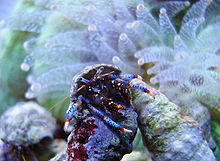- Clibanarius tricolor
-
Clibanarius tricolor 
Scientific classification Kingdom: Animalia Phylum: Arthropoda Subphylum: Crustacea Class: Malacostraca Order: Decapoda Superfamily: Paguroidea Family: Diogenidae Genus: Clibanarius Species: C. tricolor Binomial name Clibanarius tricolor
(Gibbes, 1850) [1]Synonyms Clibanarius brachyops Bouvier, 1918
Clibanarius tricolor is a hermit crab that lives in shallow water of the Caribbean Sea and is popular in the home aquarium trade. Its common names include blue-legged hermit crab, tricolor hermit crab,[1] blueleg reef hermit crab, equal handed hermit crab and blueleg hermit crab.
Contents
Description
C. tricolor has blue legs with red banding, and reaches to 2 centimeters (0.79 in) in size.[2]
Feeding
C. tricolor is a detritivore, eating dead plants and animals that would otherwise clog the reef.[3]
It also eats green hair algae, cyanobacteria and seaweed. It even sifts through sand looking for food, cleaning the sand in the process.[4]
In the aquarium
C. tricolor is a popular aquarium hermit crab because of its coloration and because its feeding habits lead it to clean tanks. It is emblematic of the public's shift from purely decorative animals to "working" animals that help sustain the aquarium's ecosystem, reducing the need for active management by the owner.[3]
References
- ^ a b "Clibanarius tricolor". Integrated Taxonomic Information System. http://www.itis.gov/servlet/SingleRpt/SingleRpt?search_topic=TSN&search_value=98191. Retrieved 29 Feb 2008.
- ^ "FishProfiles.com - Clibanarius tricolor". http://www.fishprofiles.com/files/profiles/r90012.htm. Retrieved February 28, 2008.
- ^ a b Henry Fountain (March 22, 2010). "Are Aquariums Getting Too Lifelike?". New York Times. http://www.nytimes.com/2010/03/23/science/23aquarium.html?src=sch&pagewanted=all.
- ^ "Blue leg hermit crab (Clibanarius tricolor)". http://www.peteducation.com/article.cfm?cls=16&cat=1898&articleid=2103. Retrieved February 28, 2008.
Categories:- Hermit crabs
- Crustaceans of the Atlantic Ocean
- Animals described in 1850
Wikimedia Foundation. 2010.
